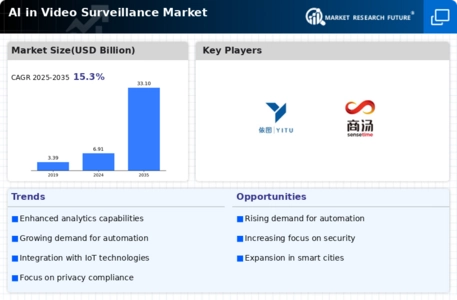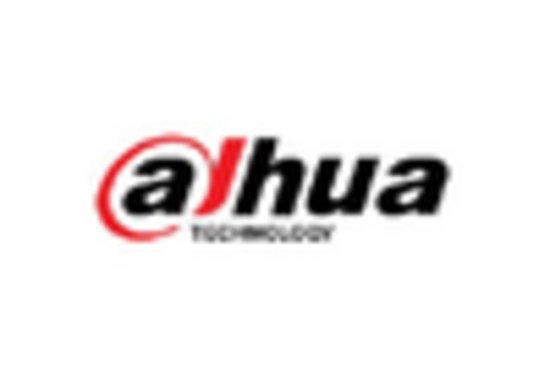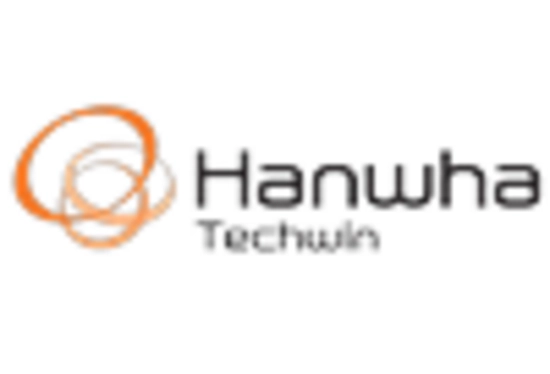Market Analysis
AI in Video Surveillance (Global, 2025)
Introduction
Artificial intelligence has revolutionized the way security is managed in many industries, including retail, transportation, and public safety. Using the vast amounts of data available from surveillance systems, these systems are able to detect and predict threats in real time. These systems are driven by the advancements in machine learning, computer vision, and big data analytics. Together, these advances enable these systems to monitor their surroundings and to identify anomalies and patterns of behavior with unprecedented accuracy. Combined with the growing importance of safety and security, the adoption of smart city initiatives is accelerating the demand for these systems. The artificial intelligence in the surveillance industry will evolve as the industry grapples with the complexities of privacy and regulatory concerns.
PESTLE Analysis
- Political
- The political background to the use of AI in surveillance will be influenced by government regulations relating to security and privacy. For example, the European Union’s General Data Protection Regulation (GDPR) stipulates strict rules for the collection and processing of personal data, with fines of up to 20 million euros or four per cent of turnover, whichever is the higher. However, the US government has allocated $1.4 billion to develop and deploy new surveillance and intelligence systems, showing a clear political commitment to using AI in law enforcement, while at the same time protecting citizens’ privacy.
- Economic
- AI in video surveillance is characterized by increased investment in security technology. The world's AI-based surveillance market is expected to exceed 10 billion U.S. dollars by 2025, driven by both the public and private security sectors. In addition, the unemployment rate in the IT industry is expected to remain low, and the demand for skilled workers with strong knowledge of artificial intelligence and machine learning, which is needed for the development and application of such systems, is also expected to be high.
- Social
- In the surveillance of a public space, the general acceptance of the use of artificial intelligence is growing. The benefits and risks of this use are becoming more widely known. In 2025, polls show that about 65% of the population in the cities is in favour of using artificial intelligence for public security, while 46% fear that their privacy will be violated. This dual attitude reflects a growing demand for the transparency and ethical use of artificial intelligence in the public sphere, which in turn forces companies to adopt more responsible practices in their surveillance solutions.
- Technological
- The market for AI in the security industry is being reshaped by technological advances. By 2025, it is expected that more than 70 per cent of surveillance cameras will be fitted with AI, which will enable them to perform such functions as facial recognition and behavior analysis. The integration of machine-learning into surveillance systems is expected to increase the accuracy of threat detection by up to 90 per cent, which will make a significant contribution to reducing response times for security personnel. The availability of high-performance computing and cloud-based solutions is also helping to drive this technological shift.
- Legal
- The legal framework regulating the use of AI in surveillance is becoming increasingly complex. By 2025, at least 15 countries are expected to have enacted laws regulating the use of AI in surveillance, with the emphasis on data protection and individual rights. For example, the Californian Consumer Privacy Act imposes strict requirements on companies regarding the collection and use of personal data and can result in fines of up to $500,000 per infringement. Companies must remain compliant with these evolving regulations to avoid heavy fines and potential legal repercussions.
- Environmental
- Artificial intelligence in surveillance systems is gaining attention, especially in terms of energy consumption and waste. It is estimated that in 2025 the energy consumption of surveillance systems based on artificial intelligence will account for 2% of the total energy consumption of the technology sector. In order to be able to meet the needs of the future, a sustainable development is needed. The life cycle of surveillance equipment is also being discussed. It is estimated that by 2025, a total of 50 million tons of electronic waste will be generated worldwide. This requires effective recycling and disposal strategies to avoid negative effects on the environment.
Porter's Five Forces
- Threat of New Entrants
- In 2025 the AI in Video Surveillance market is expected to have a moderate level of barriers to entry. Despite the fact that the development of AI solutions is becoming increasingly accessible, established players have a considerable advantage in terms of brand recognition, customer loyalty and existing infrastructure. Competition on price and innovation will be difficult for new entrants without significant investment.
- Bargaining Power of Suppliers
- The bargaining power of suppliers in the market for artificial intelligence in the surveillance market is relatively low. There are many suppliers of both hardware and software components, which reduces their individual bargaining power. Also, as the technology develops, companies can change suppliers or develop their own solutions, which further reduces the suppliers’ influence on prices and terms.
- Bargaining Power of Buyers
- AI in Surveillance Market - High - The buyers in the AI in Surveillance market have significant bargaining power due to the increasing number of options and the competitive situation. The buyers are becoming increasingly aware of the choices they have, which leads to a higher sensitivity to price and higher quality and customizability requirements. This enables the buyers to negotiate better terms and seek the most effective solutions.
- Threat of Substitutes
- The threat of substitutes in the AI in video surveillance market is moderate. There are still some traditional surveillance systems, but the advantages of AI technology are difficult to replace. Manual monitoring and other security technology are the main substitutes, and they must be continuously improved to maintain their competitiveness.
- Competitive Rivalry
- Competition in the AI in the Video Surveillance Market is Expected to Be High in 2025 The competition in the AI in the video surveillance market is expected to be intense in 2025, and the market share is disputed by many players, resulting in a number of fierce marketing strategies, continuous product innovation, and price competition. The rapid development of technology has intensified this competition, and the companies have to compete to seize the attention of the market.
SWOT Analysis
Strengths
- Advanced analytics capabilities for real-time threat detection.
- Increased accuracy in identifying and classifying objects and behaviors.
- Integration with existing security systems enhances overall effectiveness.
- Ability to process large volumes of data quickly and efficiently.
Weaknesses
- High initial investment costs for implementation.
- Dependence on data quality and availability for optimal performance.
- Potential privacy concerns and regulatory challenges.
- Complexity in system integration and maintenance.
Opportunities
- Growing demand for smart city initiatives and infrastructure.
- Expansion into new markets and sectors, such as retail and transportation.
- Advancements in machine learning and computer vision technologies.
- Increased focus on public safety and security measures post-pandemic.
Threats
- Rapid technological advancements leading to obsolescence.
- Intense competition from emerging startups and established tech firms.
- Cybersecurity risks associated with data breaches and hacking.
- Regulatory changes that may impose restrictions on surveillance practices.
Summary
Artificial intelligence in the field of video surveillance will be characterized by its strength in advanced analytics and integration capabilities, which enhance security measures. The weaknesses will be in the high cost and privacy concerns. Opportunities will come from the growing demand for smart city solutions and technological advancements. Threats will come from competition and cyber security risks. Strategic focus on innovation and compliance will be crucial for all actors to navigate the changing landscape.
















Leave a Comment